1997 TOYOTA TACOMA belt
[x] Cancel search: beltPage 27 of 221
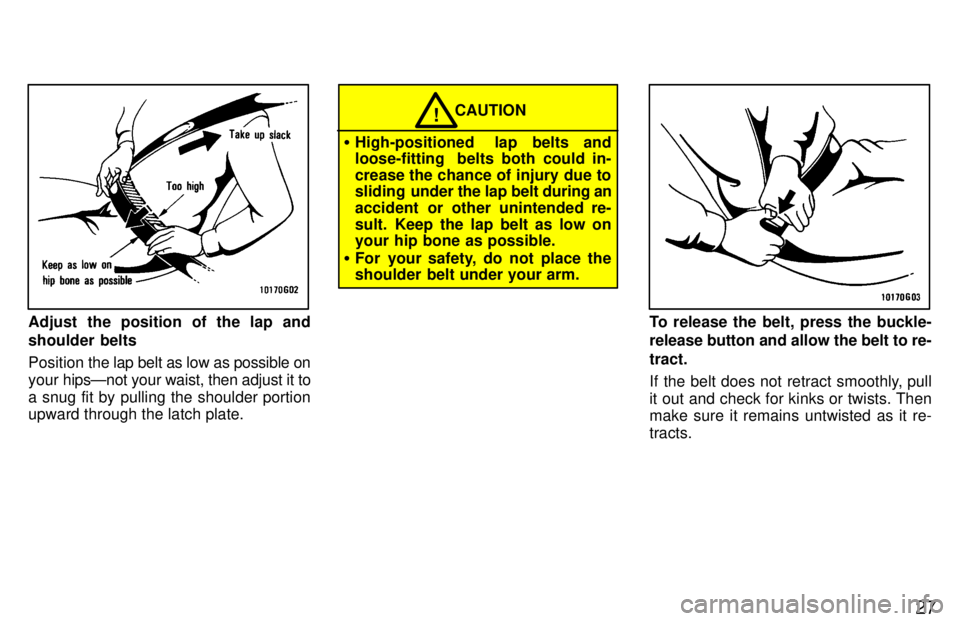
27
Adjust the position of the lap and
shoulder belts Position the lap belt as low as possible on
your hipsÐnot your waist, then adjust it to
a snug fit by pulling the shoulder portion
upward through the latch plate.
CAUTION!
� High-positioned lap belts and
loose-fitting belts both could in-
crease the chance of injury due to
sliding under the lap belt during an
accident or other unintended re-
sult. Keep the lap belt as low on
your hip bone as possible.
� For your safety, do not place the
shoulder belt under your arm.
To release the belt, press the buckle-
release button and allow the belt to re- tract.
If the belt does not retract smoothly, pull
it out and check for kinks or twists. Then make sure it remains untwisted as it re- tracts.
Page 28 of 221
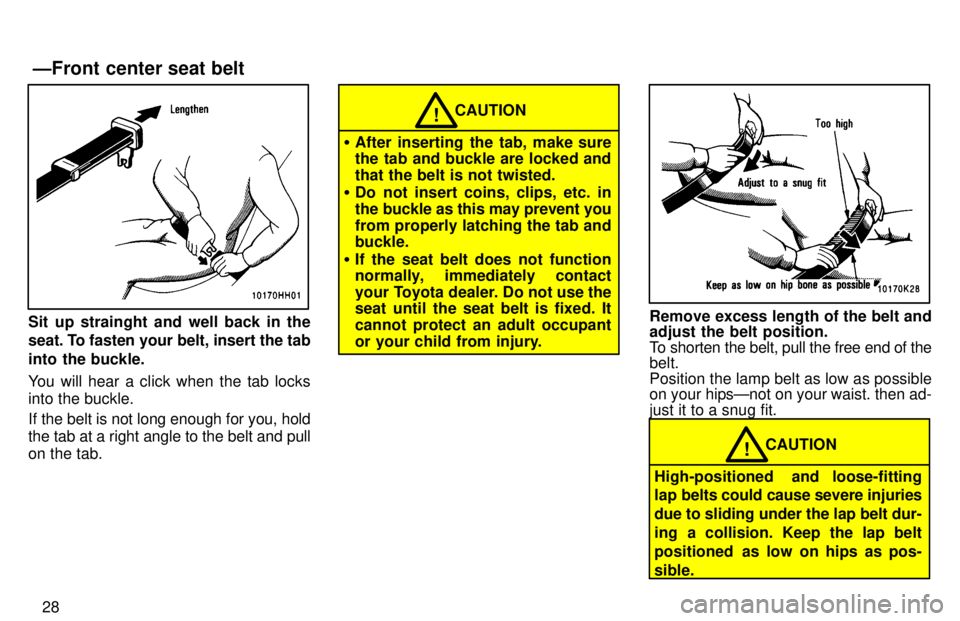
28
Sit up strainght and well back in the
seat. To fasten your belt, insert the tab
into the buckle.
You will hear a click when the tab locks into the buckle.
If the belt is not long enough for you, hold the tab at a right angle to the belt and pull
on the tab.
CAUTION!
� After inserting the tab, make sure
the tab and buckle are locked and that the belt is not twisted.
� Do not insert coins, clips, etc. in
the buckle as this may prevent you
from properly latching the tab and buckle.
� If the seat belt does not function
normally, immediately contact
your Toyota dealer. Do not use the
seat until the seat belt is fixed. It cannot protect an adult occupant
or your child from injury.
Remove excess length of the belt and adjust the belt position.
To shorten the belt, pull the free end of the belt. Position the lamp belt as low as possible
on your hipsÐnot on your waist. then ad- just it to a snug fit.
CAUTION!
High-positioned and loose-fitting
lap belts could cause severe injuries due to sliding under the lap belt dur-
ing a collision. Keep the lap belt
positioned as low on hips as pos-sible.
ÐFront center seat belt
Page 29 of 221
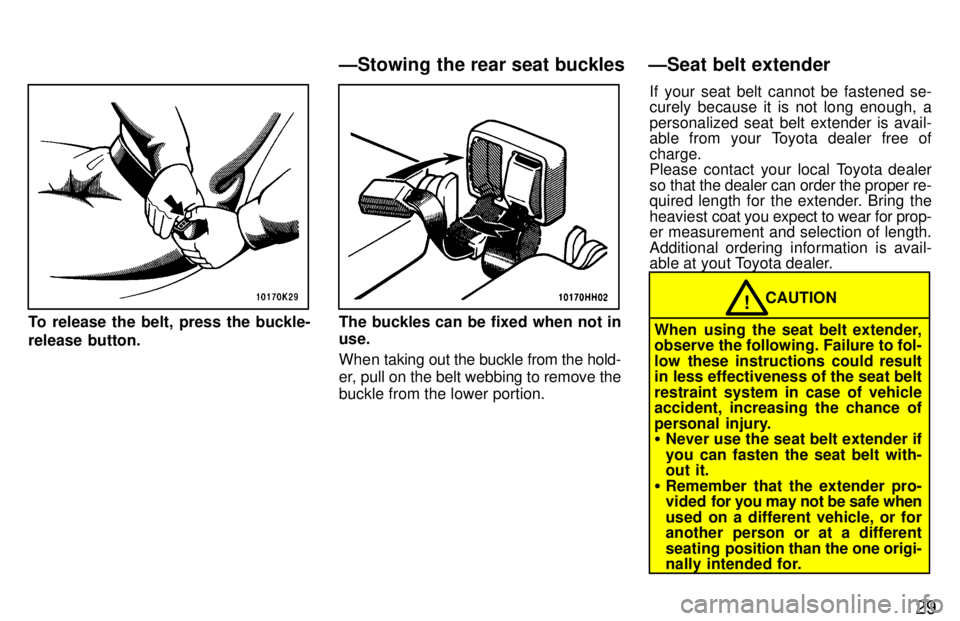
29
To release the belt, press the buckle-
release button.The buckles can be fixed when not in use.
When taking out the buckle from the hold-
er, pull on the belt webbing to remove the
buckle from the lower portion.If your seat belt cannot be fastened se- curely because it is not long enough, a
personalized seat belt extender is avail-
able from your Toyota dealer free of charge.
Please contact your local Toyota dealer
so that the dealer can order the proper re-
quired length for the extender. Bring the heaviest
coat you expect to wear for prop-
er measurement and selection of length.
Additional ordering information is avail-
able at yout Toyota dealer.
CAUTION!
When using the seat belt extender,
observe the following. Failure to fol-
low these instructions could result
in less effectiveness of the seat belt
restraint system in case of vehicle accident, increasing the chance of
personal injury. � Never use the seat belt extender if
you can fasten the seat belt with-
out it.
� Remember that the extender pro-
vided for you may not be safe when
used on a different vehicle, or for
another person or at a different
seating position than the one origi-
nally intended for.
ÐStowing the rear seat buckles ÐSeat belt extender
Page 30 of 221
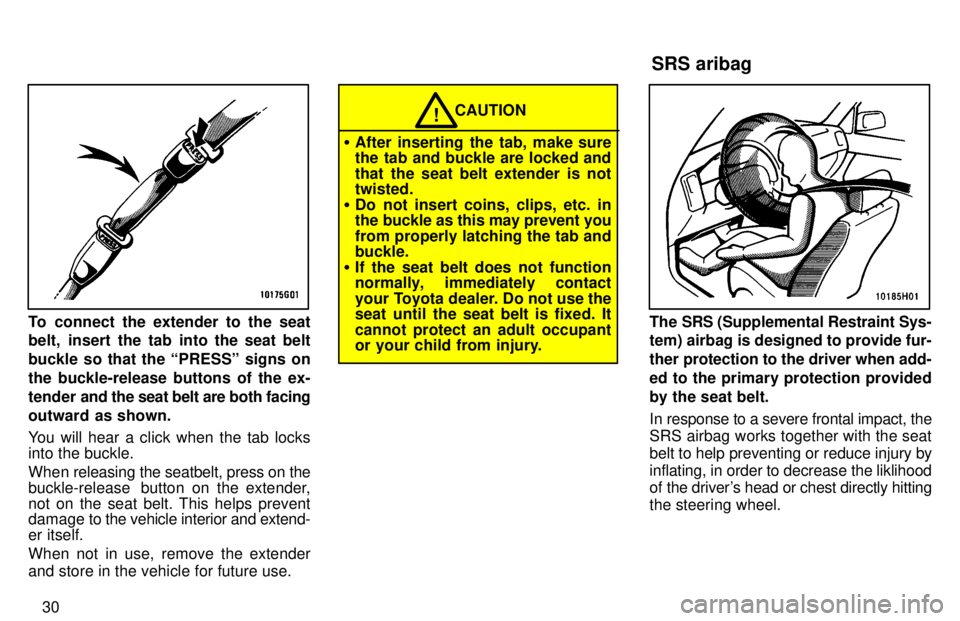
30
To connect the extender to the seat
belt, insert the tab into the seat belt
buckle so that the PRESSº signs onthe buckle-release buttons of the ex-
tender and the seat belt are both facing
outward as shown.
You will hear a click when the tab locks into the buckle.
When releasing the seatbelt, press on the
buckle-release button on the extender,not on the seat belt. This helps prevent
damage to the vehicle interior and extend- er itself.
When not in use, remove the extender
and store in the vehicle for future use.
CAUTION!
� After inserting the tab, make sure
the tab and buckle are locked and
that the seat belt extender is not twisted.
� Do not insert coins, clips, etc. in
the buckle as this may prevent you
from properly latching the tab and buckle.
� If the seat belt does not function
normally, immediately contact
your Toyota dealer. Do not use the
seat until the seat belt is fixed. It cannot protect an adult occupant
or your child from injury.
The SRS (Supplemental Restraint Sys-
tem) airbag is designed to provide fur-
ther protection to the driver when add-
ed to the primary protection providedby the seat belt.
In response to a severe frontal impact, the
SRS airbag works together with the seat
belt to help preventing or reduce injury byinflating, in order to decrease the liklihood
of the driver's head or chest directly hitting the steering wheel. SRS aribag
Page 31 of 221

31
This indicator comes on when the
ignition key is turned to the ACCº or
ONº position. It goes off after about 6
seconds. This means the SRS airbag
is operating properly.
The SRS airbag warning light system
monitors the airbag sensor assembly, in-
flators, warning light, interconnecting wir-
ing and power sourcesThe SRS airbag system is designed to
activate in response to a severe frontal
impact within the shaded area be-
tween the arrows in the illustration.
The SRS airbags will deploy if the severity
of the impact is above the designed
threshold level, comparable to an approxi-
mate 20 km/h (14 mph) collision when im-
pacting straight into a fixed barrier that
does not move or deform.
If the severity of the impact is below the
above threshold level, the SRS airbags
may not deploy. However, this threshold velocity will be
considerably higher if the vehicle strikes
an object, such as a parked vehicle or sign
pole, which can move or deform on im-
pact, or if it is
involved in an underride col-
lision (e.g. a collision in which the noise of
the vehicle underridesº, or goes under, the bed of a truck).
For the safety of all occupants, be sure to
always wear your seat belts.
Page 33 of 221
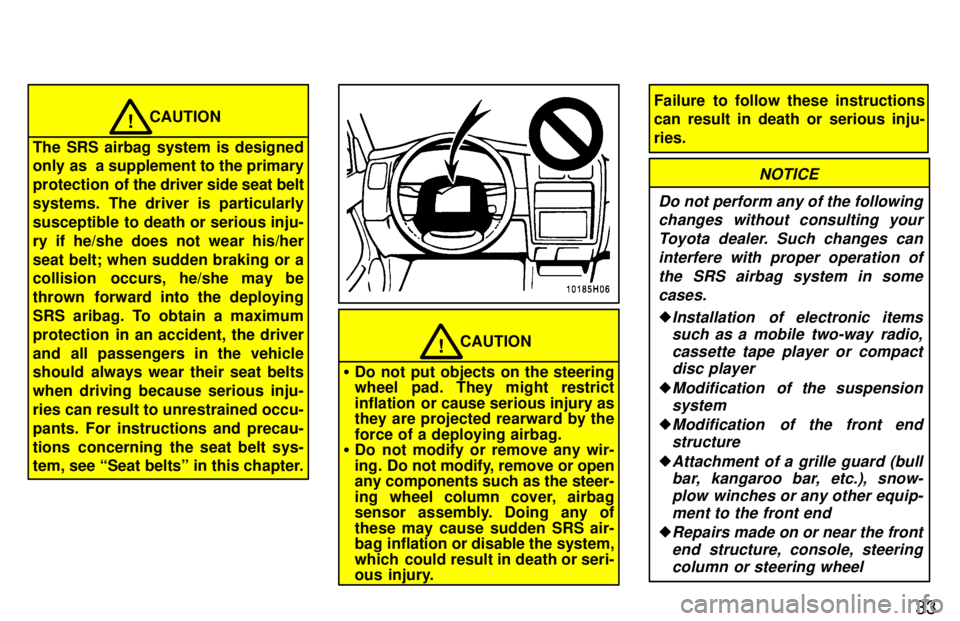
33
CAUTION!
The SRS airbag system is designed
only as a supplement to the primary
protection of the driver side seat belt
systems. The driver is particularly
susceptible to death or serious inju-
ry if he/she does not wear his/her
seat belt; when sudden braking or a
collision occurs, he/she may be
thrown forward into the deploying
SRS aribag. To obtain a maximum
protection in an accident, the driver
and all passengers in the vehicle
should always wear their seat belts when driving because serious inju-
ries can result to unrestrained occu-
pants. For instructions and precau-
tions concerning the seat belt sys-
tem, see Seat beltsº in this chapter.
CAUTION!
� Do not put objects on the steering
wheel pad. They might restrict
inflation or cause serious injury as
they are projected rearward by the force of a deploying airbag.
� Do not modify or remove any wir-
ing. Do not modify, remove or open any components such as the steer-
ing wheel column cover, airbag
sensor assembly. Doing any of
these may cause sudden SRS air-
bag inflation or disable the system,
which could result in death or seri-
ous injury.
Failure to follow these instructions can result in death or serious inju- ries.
NOTICE
Do not perform any of the following changes without consulting your
Toyota dealer. Such changes caninterfere with proper operation of the SRS airbag system in somecases.
�Installation of electronic itemssuch as a mobile two-way radio,
cassette tape player or compactdisc player
�Modification of the suspension
system
�Modification of the front endstructure
�Attachment of a grille guard (bullbar, kangaroo bar, etc.), snow-
plow winches or any other equip-
ment to the front end
�Repairs made on or near the front end structure, console, steeringcolumn or steering wheel
Page 34 of 221
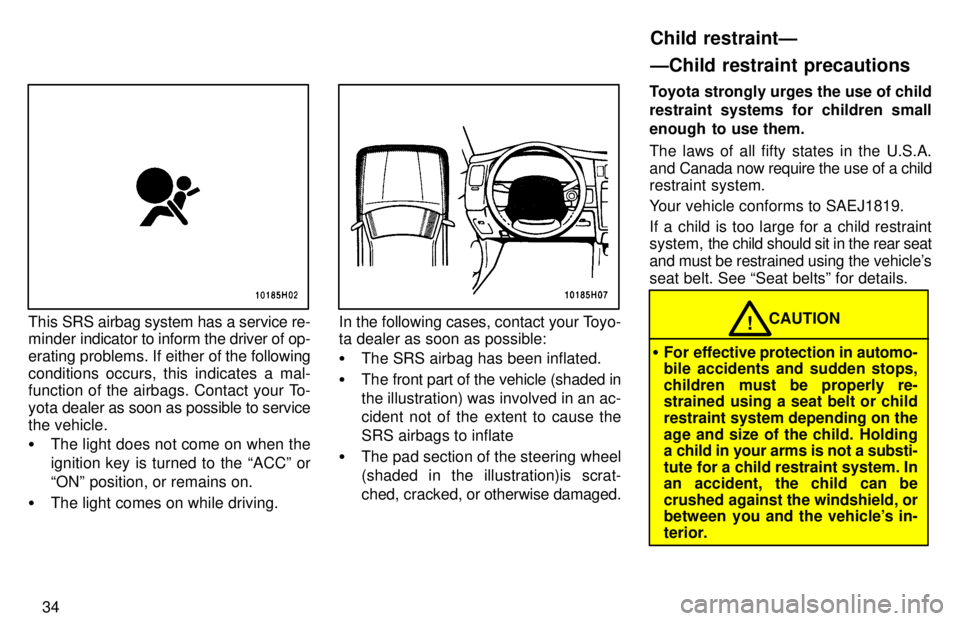
34
This SRS airbag system has a service re-
minder indicator to inform the driver of op-
erating problems. If either of the following
conditions occurs, this indicates a mal-
function of the airbags. Contact your To-
yota dealer as soon as possible to service
the vehicle. � The light does not come on when the
ignition key is turned to the ACCº or
ONº position, or remains on.
� The light comes on while driving.In the following cases, contact your Toyo-
ta dealer as soon as possible: �The SRS airbag has been inflated.
� The front part of the vehicle (shaded in the illustration) was involved in an ac-
cident not of the extent to cause the
SRS airbags to inflate
� The pad section of the steering wheel
(shaded in the illustration)is scrat-
ched, cracked, or otherwise damaged. Toyota strongly urges the use of child
restraint systems for children small
enough to use them.
The laws of all fifty states in the U.S.A.
and Canada now require the use of a child
restraint system.
Your vehicle conforms to SAEJ1819.
If a child is too large for a child restraint
system,
the child should sit in the rear seat
and must be restrained using the vehicle's
seat belt. See Seat beltsº for details.CAUTION!
� For effective protection in automo-
bile accidents and sudden stops,
children must be properly re-
strained using a seat belt or child
restraint system depending on the
age and size of the child. Holding
a child in your arms is not a substi-
tute for a child restraint system. In
an accident, the child can be
crushed against the windshield, or
between you and the vehicle's in-
terior.
Child restraintÐ ÐChild restraint precautions
Page 35 of 221
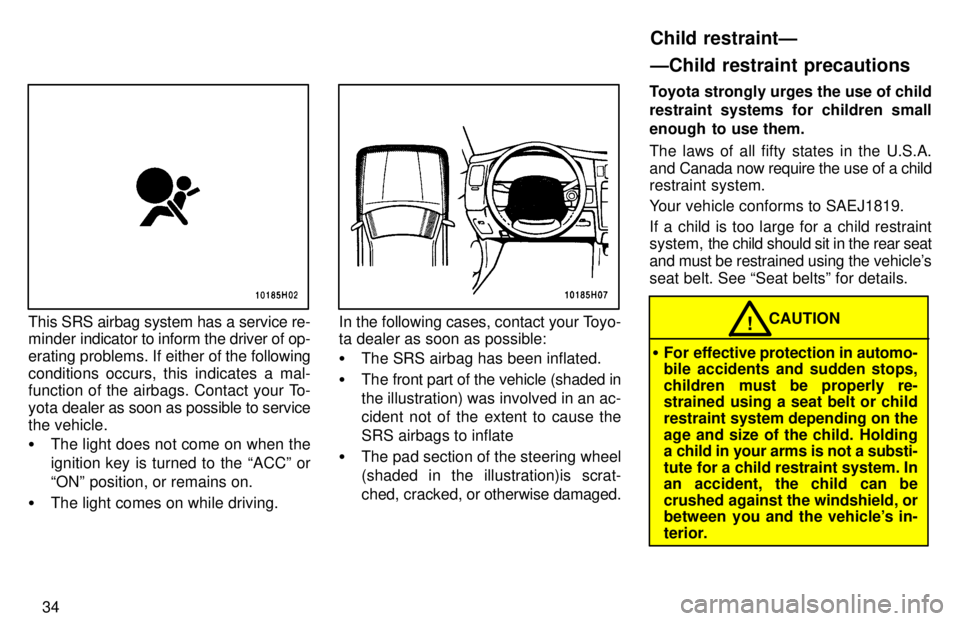
34
This SRS airbag system has a service re-
minder indicator to inform the driver of op-
erating problems. If either of the following
conditions occurs, this indicates a mal-
function of the airbags. Contact your To-
yota dealer as soon as possible to service
the vehicle. � The light does not come on when the
ignition key is turned to the ACCº or
ONº position, or remains on.
� The light comes on while driving.In the following cases, contact your Toyo-
ta dealer as soon as possible: �The SRS airbag has been inflated.
� The front part of the vehicle (shaded in the illustration) was involved in an ac-
cident not of the extent to cause the
SRS airbags to inflate
� The pad section of the steering wheel
(shaded in the illustration)is scrat-
ched, cracked, or otherwise damaged. Toyota strongly urges the use of child
restraint systems for children small
enough to use them.
The laws of all fifty states in the U.S.A.
and Canada now require the use of a child
restraint system.
Your vehicle conforms to SAEJ1819.
If a child is too large for a child restraint
system,
the child should sit in the rear seat
and must be restrained using the vehicle's
seat belt. See Seat beltsº for details.CAUTION!
� For effective protection in automo-
bile accidents and sudden stops,
children must be properly re-
strained using a seat belt or child
restraint system depending on the
age and size of the child. Holding
a child in your arms is not a substi-
tute for a child restraint system. In
an accident, the child can be
crushed against the windshield, or
between you and the vehicle's in-
terior.
Child restraintÐ ÐChild restraint precautions